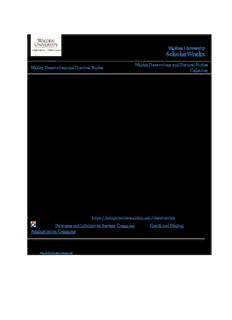
Technology Acceptance and Compliance in Obstructive Sleep Apnea Patients PDF
Preview Technology Acceptance and Compliance in Obstructive Sleep Apnea Patients
Walden University ScholarWorks Walden Dissertations and Doctoral Studies Walden Dissertations and Doctoral Studies Collection 2018 Technology Acceptance and Compliance in Obstructive Sleep Apnea Patients Asif Kidwai Walden University Follow this and additional works at:https://scholarworks.waldenu.edu/dissertations Part of theDatabases and Information Systems Commons, and theHealth and Medical Administration Commons This Dissertation is brought to you for free and open access by the Walden Dissertations and Doctoral Studies Collection at ScholarWorks. It has been accepted for inclusion in Walden Dissertations and Doctoral Studies by an authorized administrator of ScholarWorks. For more information, please [email protected]. Walden University College of Management and Technology This is to certify that the doctoral dissertation by Asif Kidwai has been found to be complete and satisfactory in all respects, and that any and all revisions required by the review committee have been made. Review Committee Dr. Anthony Lolas, Committee Chairperson, Applied Management and Decision Sciences Faculty Dr. Hamid Kazeroony, Committee Member, Applied Management and Decision Sciences Faculty Dr. Robert Haussmann, University Reviewer Applied Management and Decision Sciences Faculty Chief Academic Officer Eric Riedel, Ph.D. Walden University 2018 Abstract Technology Acceptance and Compliance in Obstructive Sleep Apnea Patients by Asif Kidwai MSM, Oakland City University, 2002 MSc, Arkansas State University, 1997 BSc, Arkansas State University, 1995 Dissertation Submitted in Partial Fulfillment of the Requirements for the Degree of Doctor of Philosophy Information Technology Management Walden University May 2018 Abstract The focus of this study is the problem of declining trend in obstructive sleep apnea (OSA) patient compliance. Studies reported improved compliance in patients with chronic diseases due to technology-based interventions. However, researchers have not investigated the advantages of technology to improve the compliance of OSA patients in detail. The specific problem was the lack of engagement between patients and healthcare managers, resulting in low compliance within OSA patients. The purpose of this qualitative study was to evaluate how technology-based interventions can improve OSA patient engagement with the healthcare managers resulting in improved compliance with treatment procedures. In this study, the technology acceptance model was used as the instrument in evaluating the information collected through interviews with 20 healthcare managers about their attitudes toward usage, perceived usefulness, and perceived ease of use. The transcribed interviews were open-coded using the RQDA library in R Studio. In general, results from this study indicated that the healthcare managers showed a positive attitude towards the use of technology for patient engagement and expressed that the technology is useful for patient engagement and is easier to use. However, they identified technology-related and patient-related challenges in implementing technology for patient engagement. Further, the respondents identified process-related and patient-related opportunities in using technology for patient engagement. Results from this study have practice and policy implications by enabling healthcare managers to devise better compliance plans for OSA patient management. The findings could have a social benefit by helping healthcare managers to implement technology-based interventions to better achieve a higher compliance resulting in better patient health at lower costs. Technology Acceptance and Compliance in Obstructive Sleep Apnea Patients by Asif Kidwai MSM, Oakland City University, 2002 MSc, Arkansas State University, 1997 BSc, Arkansas State University, 1995 Dissertation Submitted in Partial Fulfillment Of the Requirements for the Degree of Doctor of Philosophy Information Technology Management Walden University March 2018 Dedication In dedication to my father, Mr. Manzoor Karim Kidwai, and mother, Mrs. Zakia Kidwai, for making me who I am today, and my wife, Hanniya, son, Raafay, and my daughters, Miriam and Raania, for supporting me all the way. Acknowledgments It is with my deepest gratitude and warmest affection that I dedicate this dissertation to Dr. Anthony Lolas, who has been a constant source of knowledge and inspiration to me throughout this journey. Table of Contents List of Figures ......................................................................................................................v List of Tables ..................................................................................................................... vi Chapter 1: Introduction to this Study ...................................................................................1 Background of this Study...............................................................................................3 Problem Statement .........................................................................................................9 Purpose of the Study ....................................................................................................10 Research Questions ......................................................................................................11 Conceptual Framework ................................................................................................13 Nature of the Study ......................................................................................................16 Definitions of Terms ....................................................................................................16 Assumptions .................................................................................................................17 Scope and Delimitations ..............................................................................................17 Limitations ...................................................................................................................18 Significance of Study ...................................................................................................18 Significance to Business Practice ......................................................................... 18 Significance to Positive Social Change ................................................................ 19 Summary ......................................................................................................................20 Chapter 2: Literature Review .............................................................................................21 Introduction ..................................................................................................................21 Literature Review Areas ....................................................................................... 22 Methodology of the Literature Review ........................................................................22 i Type of Review ..................................................................................................... 22 Literature Search Strategy..................................................................................... 23 Inclusion and Exclusion Criteria ........................................................................... 24 Criteria for Data Extraction .................................................................................. 24 Data Synthesis Criteria ......................................................................................... 25 Study Characteristics ............................................................................................ 26 Appraisal of Quality .............................................................................................. 26 Role of Information Systems in Patient Engagement ..................................................27 Role of Technology in Chronic Disease Management ......................................... 29 Technology in Obstructive Sleep Apnea Management ........................................ 42 Technology Acceptance Model ............................................................................ 46 Improving Patient Compliance with Sleep Apnea Treatment with Technology ............................................................................................... 50 Other Approaches to Improve Compliance With Sleep Apnea Treatment ........... 53 Summary ......................................................................................................................58 Chapter 3: Research Methodology.....................................................................................60 Introduction ..................................................................................................................60 Objectives of the Research Design ..............................................................................62 Research Questions ......................................................................................................62 Foundation of the Research Paradigm .........................................................................63 Conceptual Perspective ................................................................................................65 Research Design and Approach ...................................................................................66 ii Sampling Strategy and Participants .............................................................................69 Role of the Researcher .................................................................................................69 Data Collection and Analysis.......................................................................................70 Instrumentation ............................................................................................................70 Ethical Concerns ..........................................................................................................71 Summary ......................................................................................................................72 Chapter 4: Results ..............................................................................................................73 Research Setting...........................................................................................................74 Demographic Characteristics .......................................................................................75 Data Collection ............................................................................................................76 Data Analysis ...............................................................................................................78 Evidence of Trustworthiness........................................................................................79 Credibility ............................................................................................................. 80 Dependability ........................................................................................................ 80 Confirmability ....................................................................................................... 81 Transferability ....................................................................................................... 81 Study Results ...............................................................................................................81 Interview Question 3 ............................................................................................. 83 Interview Question 4 ............................................................................................. 90 Interview Question 5 ........................................................................................... 103 Interview Question 6 ........................................................................................... 107 Interview Question 7 ........................................................................................... 109 iii
Description: